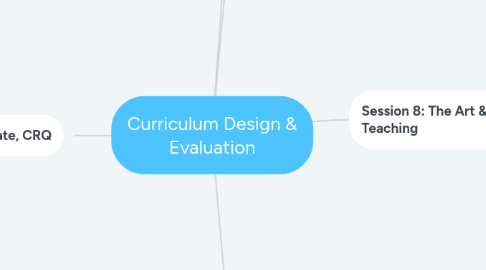
1. Introducing relevance first and then the textbook second.
2. Session 4: LP Cycle, Inovate, CRQ
2.1. Madi Hunter: Lesson Plan Cycle
2.1.1. Beginning
2.1.1.1. Anticipatory Set
2.1.1.1.1. Objective
2.1.1.1.2. Prior Knowledge/Review
2.1.1.1.3. Hook
2.1.1.1.4. Relevance
2.1.1.1.5. Social Emotional Feedback
2.1.2. Middle
2.1.2.1. Direct Teach
2.1.2.1.1. Content Knowledge w/ Questions
2.1.2.1.2. Objective Steps
2.1.2.1.3. I-Do
2.1.2.2. Guided Practice
2.1.2.2.1. Groups
2.1.2.2.2. We-Do
2.1.2.2.3. BRAIN BREAK!
2.1.2.3. Independent Practice
2.1.2.3.1. Voice & Choice
2.1.2.3.2. Students as Designers
2.1.2.3.3. You-Do
2.1.3. End
2.1.3.1. Closure
2.1.3.1.1. Reminder of Objective
2.1.3.1.2. Celebration of Mastery
2.1.3.1.3. Reflection
2.1.3.1.4. Summative Assessment
2.2. Innovate Inside The Box
2.2.1. Chapter 1
2.2.1.1. Small things matter
2.2.1.1.1. Little personal touches set the tone for the classroom.
2.2.2. Chapter 2
2.2.2.1. Learner Driven. Evidence Informed.
2.2.3. Chapter 3
2.2.3.1. Student engagement is the goal via empowered learning experiences.
2.2.3.1.1. What will I learn?
2.2.3.1.2. What will I solve?
2.2.3.1.3. What will I create?
2.2.4. Chapter 4
2.2.4.1. Master Learner. Master Educator.
2.2.4.1.1. Growth is essential when the target is always moving.
2.2.5. Chapter 5-6
2.2.5.1. Empathy.
2.2.5.1.1. How can we partner with students to create opportunities to develop empathy?
2.2.5.1.2. Creates a culture of meaning and relevance.
2.2.5.2. Problem Finders/Solvers
2.2.5.2.1. Creating opportunities for the students to lead in the classroom.
2.2.5.2.2. Requires a deep level of trust.
2.2.6. Chapter 7-8
2.2.6.1. Risk-Takers
2.2.6.1.1. Developing a culture of risk taking
2.2.6.1.2. Leading by modeling.
2.2.6.1.3. Creating a culture where failure is encouraged.
2.2.6.2. Networked.
2.2.6.2.1. Family Hook ups
2.2.6.2.2. Creating a culture of networking.
2.2.7. Chapter 9-10
2.2.7.1. Observant.
2.2.7.1.1. Taking time to watch your students to know them.
2.2.7.2. Creators
2.2.7.2.1. Students should be involved in the learning process by developing things that matter to them.
2.2.7.2.2. Providing great models of creativity.
2.2.8. Chapter 11-12
2.2.8.1. Resilient.
2.2.8.1.1. Pathway forward is built through failure.
2.2.8.2. Reflection.
2.2.8.2.1. Giving our kids time to take a moment to marinate.
2.2.8.2.2. Create space & time for learning to be a source of joy.
2.2.9. Chapter 13-14
2.2.9.1. Lead from where you are.
2.2.9.2. You are the core.
2.3. Dr. McHaney CRQ Feedback
2.3.1. Do CRQ First?
2.3.2. Go to the Question. Read the Question
2.3.2.1. Name the problem before we fix the problem.
2.3.3. Justify the Answer w/ Textual Evidence
2.3.3.1. Evidence Informed
2.3.3.2. Values Driven, Data Informed.
2.3.4. Levels of Coaching
2.3.4.1. Reflective Coaching
2.3.4.1.1. Teacher owns the process
2.3.4.2. Informative Coaching
2.3.4.2.1. Throw in some suggestions
2.3.4.2.2. Let the teacher take ownership
2.3.4.3. Directive Coaching
2.3.4.3.1. Do this.
2.3.4.3.2. Lowest level.
2.3.5. How Not Why
2.3.5.1. Prepare Coaching Questions Beforehand
2.3.5.2. Positive Presupposition Question
2.3.5.3. Bring the teacher back to the standard.
3. Understanding By Design
3.1. Opening the pool of shared "buy-in"
3.2. Beginning with what I want the students to KNOW and what I expect them to DO with the information.
3.3. Creating an order by beginning with the desired results...
3.4. The textbook follows the Socratic question.
3.5. UBD is a "Planning Framework."
4. Session 8: The Art & Science of Teaching
4.1. Essential Questions
4.1.1. THESE DRIVE THE LESSON.
4.2. Created to be a plethora of tools to be used in teaching.
4.2.1. Feedback
4.2.1.1. Chapter 1-2
4.2.1.1.1. Scales v. Rubrics
4.2.2. Content
4.2.2.1. Chapter 3-6
4.2.2.1.1. Chunking & Processing
4.2.2.1.2. Guided Practice, Similarities & Differences, and Examining Errors.
4.2.2.1.3. Conducting Knowledge Application Lessons
4.2.2.1.4. Integrating NEW knowledge w/ OLD knowledge.
4.2.3. Context
4.2.3.1. Chapter 7-10
4.2.3.1.1. Cultivating Engagement
4.2.3.1.2. Implementing Rules & Procedures
4.2.3.1.3. Building Relationships
4.2.3.1.4. Communicating High Expectations
4.2.3.1.5. Making System Changes
5. Fenwick To Teach & Test
5.1. Curriculum Design Principles
5.1.1. This is an oldie, basic principles of design, etc...
5.2. Written
5.2.1. Formal Curriculum
5.2.2. In Texas, mostly from TEKS
5.2.3. Private Schools writing their own.
5.3. Taught
5.3.1. Delivery based
5.3.2. Heavily reliant on teacher
5.3.3. Informal, Formal, and Hidden
5.4. Tested
5.4.1. Summative and Formative
5.4.2. Provides data to understand the effectiveness of the curriculum
